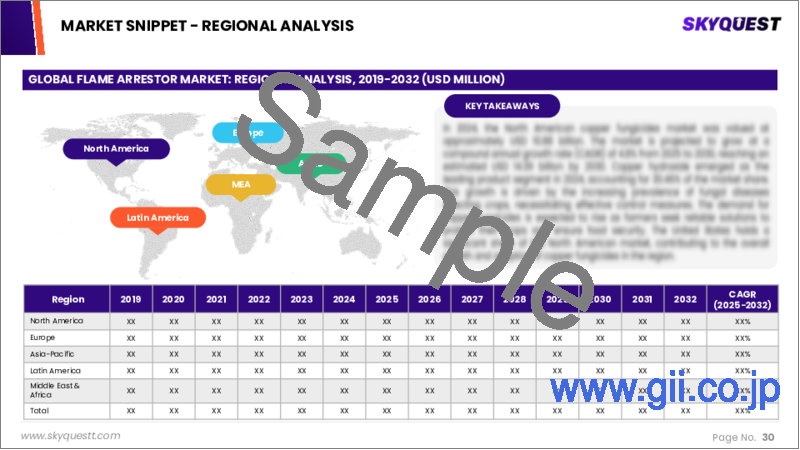|
|
市場調査レポート
商品コード
1640200
フレームアレスターの市場規模、シェア、成長分析:タイプ別、用途別、エンドユーザー別、地域別 - 産業予測、2025年~2032年Flame Arrestor Market Size, Share, Growth Analysis, By Type (In-line, End-of-line), By Application (Storage Tank, Pipeline), By End-user, By Region - Industry Forecast 2025-2032 |
||||||
|
|||||||
| フレームアレスターの市場規模、シェア、成長分析:タイプ別、用途別、エンドユーザー別、地域別 - 産業予測、2025年~2032年 |
|
出版日: 2025年01月21日
発行: SkyQuest
ページ情報: 英文 184 Pages
納期: 3~5営業日
|
全表示
- 概要
- 目次
世界のフレームアレスターの市場規模は、2023年に9億2,470万米ドルとなり、2024年の9億8,388万米ドルから、2032年までには16億1,613万米ドルに成長し、予測期間(2025年~2032年)のCAGRは6.4%で成長する見通しです。
爆発防止器市場は、特に石油・ガス分野での安全規制の強化に対応した難燃剤の採用拡大が成長の原動力となっています。引火性の高い物質を扱う産業では、各国が火災予防と事故管理を優先しているため、特に中国、インド、インドネシアといったアジア太平洋の新興経済諸国では、難燃剤が不可欠な部品になりつつあります。この地域では、中小企業は高度な保護装置に投資するよりもリスクの高いガスカーテン方式に頼ることが多く、市場全体の成長を妨げています。しかし、安全対策の強化を目的とした政府の取り組みにより、さまざまな用途で難燃剤の利用が加速すると予想されます。このダイナミックな情勢は、可燃性環境における安全性を優先する方向への重要な転換を意味し、大きな市場機会を提供しています。
目次
イントロダクション
- 調査の目的
- 調査範囲
- 定義
調査手法
- 情報調達
- 二次データと一次データの方法
- 市場規模予測
- 市場の前提条件と制限
エグゼクティブサマリー
- 世界市場の見通し
- 供給と需要の動向分析
- セグメント別機会分析
市場力学と見通し
- 市場概要
- 市場規模
- 市場力学
- 促進要因と機会
- 抑制要因と課題
- ポーターの分析
主要な市場の考察
- 主要な成功要因
- 競合の程度
- 主要な投資機会
- 市場エコシステム
- 市場の魅力指数(2024年)
- PESTEL分析
- マクロ経済指標
- バリューチェーン分析
- 価格分析
世界のフレームアレスターの市場規模:タイプ別・CAGR(2025年~2032年)
- 市場概要
- インライン
- エンドオブライン
世界のフレームアレスターの市場規模:用途別・CAGR(2025年~2032年)
- 市場概要
- 貯蔵タンク
- パイプライン
- 焼却炉
- 換気システム
- その他
世界のフレームアレスターの市場規模:エンドユーザー別・CAGR(2025年~2032年)
- 市場概要
- 石油・ガス
- 化学薬品
- 金属・鉱業
- 製薬
- 廃棄物発電プラント
- その他
世界のフレームアレスターの市場規模・CAGR(2025年~2032年)
- 北米
- 米国
- カナダ
- 欧州
- ドイツ
- スペイン
- フランス
- 英国
- イタリア
- その他欧州地域
- アジア太平洋
- 中国
- インド
- 日本
- 韓国
- その他アジア太平洋
- ラテンアメリカ
- ブラジル
- その他ラテンアメリカ地域
- 中東・アフリカ
- GCC諸国
- 南アフリカ
- その他中東・アフリカ
競合情報
- 上位5社の比較
- 主要企業の市場ポジショニング(2024年)
- 主な市場企業が採用した戦略
- 市場の最近の動向
- 企業の市場シェア分析(2024年)
- 主要企業の企業プロファイル
- 会社概要
- 製品ポートフォリオ分析
- 企業のセグメント別シェア分析
- 収益の前年比比較(2022年~2024年)
主要企業プロファイル
- Emerson Electric Co.(USA)
- Elmac Technologies Ltd(UK)
- PROTEGO Braunschweiger Flammenfilter GmbH(Germany)
- The Protectoseal Company Inc.(USA)
- WITT-Gasetechnik GmbH & Co KG(Germany)
- L&J Technologies(USA)
- Westech Industrial Ltd.(Canada)
- Groth Corporation(USA)
- Motherwell Tank Protection(UK)
- Morrison Bros. Co.(USA)
- Tornado Combustion Technologies(USA)
- Ergil(Turkey)
- BS&B Safety Systems(USA)
- Shand & Jurs(USA)
- Fluidyne Instruments Pvt. Ltd(India)
- Flammer GmbH(Germany)
- Essex Industries, Inc.(USA)
- Cross Company(USA)
- Tornillos Gual SL(Spain)
- Storagetech(Turkey)
結論と提言
Global Flame Arrestor Market size was valued at USD 924.7 million in 2023 and is poised to grow from USD 983.88 million in 2024 to USD 1616.13 million by 2032, growing at a CAGR of 6.4% during the forecast period (2025-2032).
The explosion arrester market is poised for growth, driven by increasing adoption of flame retardants in response to heightened safety regulations, particularly in the oil and gas sector. As nations prioritize fire prevention and incident management in industries with highly flammable materials, flame retardants are becoming essential components, especially in Asia Pacific's developing economies like China, India, and Indonesia. Here, small and medium enterprises often resort to riskier gas curtain schemes rather than investing in advanced protective devices, which hampers overall market growth. However, government initiatives aimed at reinforcing safety measures are expected to accelerate flame retardant utilization across various applications. This dynamic landscape signifies a critical shift towards prioritizing safety in flammable environments, offering significant market opportunities.
Top-down and bottom-up approaches were used to estimate and validate the size of the Global Flame Arrestor market and to estimate the size of various other dependent submarkets. The research methodology used to estimate the market size includes the following details: The key players in the market were identified through secondary research, and their market shares in the respective regions were determined through primary and secondary research. This entire procedure includes the study of the annual and financial reports of the top market players and extensive interviews for key insights from industry leaders such as CEOs, VPs, directors, and marketing executives. All percentage shares split, and breakdowns were determined using secondary sources and verified through Primary sources. All possible parameters that affect the markets covered in this research study have been accounted for, viewed in extensive detail, verified through primary research, and analyzed to get the final quantitative and qualitative data.
Global Flame Arrestor Market Segmental Analysis
Global Flame Arrestor Market is segmented by Type, Application, End-user and region. Based on Type, the market is segmented into In-line and End-of-line. Based on Application, the market is segmented into Storage Tank, Pipeline, Incinerator, Ventilation System and Others. Based on End-user, the market is segmented into Oil & Gas, Chemical, Metals & Mining, Pharmaceutical, Waste-to-energy Plant and Others. Based on region, the market is segmented into North America, Europe, Asia Pacific, Latin America and Middle East & Africa.
Driver of the Global Flame Arrestor Market
The global flame arrestor market is significantly influenced by industrial safety regulations. Stringent safety standards and guidelines established by regulatory bodies and industry organizations propel the adoption of flame arrestors across various sectors, including oil, gas, petrochemicals, chemicals, and pharmaceuticals. These industries prioritize the implementation of safety measures to mitigate the risks associated with fire and explosion hazards. As a result, the growing emphasis on compliance with safety regulations not only fosters the acceptance of flame arrestor technologies but also underlines their importance in safeguarding personnel, assets, and the environment from potential fire-related incidents.
Restraints in the Global Flame Arrestor Market
The global flame arrestor market faces notable constraints due to the volatility of crude oil and gas prices, which can significantly hinder investments throughout the forecast period. Fluctuations in these energy prices directly influence the production costs of many refractories derived from fuel cells. Specifically, when crude oil prices rise, the expenses associated with refractory products tend to increase, consequently elevating their market price. On the other hand, periods of high oil prices may lead to a decline in production costs, further complicating the market dynamics. This uncertainty discourages investment and disrupts production planning, ultimately affecting market growth.
Market Trends of the Global Flame Arrestor Market
The global flame arrestor market is poised for significant growth, driven by ongoing technological advancements that are gradually replacing outdated flame-retardant products. The oil and gas sector is anticipated to be a key contributor to this market evolution, bolstered by rising annual production levels and enhanced finishing capacities. This surge in activity not only heightens the need for reliable fire safety solutions but also propels innovation and adoption of advanced flame arrestor technologies. As industries increasingly prioritize safety and regulatory compliance, the flames arrestor market is expected to expand globally, presenting lucrative opportunities for manufacturers and suppliers in the coming years.
Table of Contents
Introduction
- Objectives of the Study
- Scope of the Report
- Definitions
Research Methodology
- Information Procurement
- Secondary & Primary Data Methods
- Market Size Estimation
- Market Assumptions & Limitations
Executive Summary
- Global Market Outlook
- Supply & Demand Trend Analysis
- Segmental Opportunity Analysis
Market Dynamics & Outlook
- Market Overview
- Market Size
- Market Dynamics
- Drivers & Opportunities
- Restraints & Challenges
- Porters Analysis
- Competitive rivalry
- Threat of substitute
- Bargaining power of buyers
- Threat of new entrants
- Bargaining power of suppliers
Key Market Insights
- Key Success Factors
- Degree of Competition
- Top Investment Pockets
- Market Ecosystem
- Market Attractiveness Index, 2024
- PESTEL Analysis
- Macro-Economic Indicators
- Value Chain Analysis
- Pricing Analysis
Global Flame Arrestor Market Size by Type & CAGR (2025-2032)
- Market Overview
- In-line
- End-of-line
Global Flame Arrestor Market Size by Application & CAGR (2025-2032)
- Market Overview
- Storage Tank
- Pipeline
- Incinerator
- Ventilation System
- Others
Global Flame Arrestor Market Size by End-user & CAGR (2025-2032)
- Market Overview
- Oil & Gas
- Chemical
- Metals & Mining
- Pharmaceutical
- Waste-to-energy Plant
- Others
Global Flame Arrestor Market Size & CAGR (2025-2032)
- North America (Type, Application, End-user)
- US
- Canada
- Europe (Type, Application, End-user)
- Germany
- Spain
- France
- UK
- Italy
- Rest of Europe
- Asia Pacific (Type, Application, End-user)
- China
- India
- Japan
- South Korea
- Rest of Asia-Pacific
- Latin America (Type, Application, End-user)
- Brazil
- Rest of Latin America
- Middle East & Africa (Type, Application, End-user)
- GCC Countries
- South Africa
- Rest of Middle East & Africa
Competitive Intelligence
- Top 5 Player Comparison
- Market Positioning of Key Players, 2024
- Strategies Adopted by Key Market Players
- Recent Developments in the Market
- Company Market Share Analysis, 2024
- Company Profiles of All Key Players
- Company Details
- Product Portfolio Analysis
- Company's Segmental Share Analysis
- Revenue Y-O-Y Comparison (2022-2024)
Key Company Profiles
- Emerson Electric Co. (USA)
- Company Overview
- Business Segment Overview
- Financial Updates
- Key Developments
- Elmac Technologies Ltd (UK)
- Company Overview
- Business Segment Overview
- Financial Updates
- Key Developments
- PROTEGO Braunschweiger Flammenfilter GmbH (Germany)
- Company Overview
- Business Segment Overview
- Financial Updates
- Key Developments
- The Protectoseal Company Inc. (USA)
- Company Overview
- Business Segment Overview
- Financial Updates
- Key Developments
- WITT-Gasetechnik GmbH & Co KG (Germany)
- Company Overview
- Business Segment Overview
- Financial Updates
- Key Developments
- L&J Technologies (USA)
- Company Overview
- Business Segment Overview
- Financial Updates
- Key Developments
- Westech Industrial Ltd. (Canada)
- Company Overview
- Business Segment Overview
- Financial Updates
- Key Developments
- Groth Corporation (USA)
- Company Overview
- Business Segment Overview
- Financial Updates
- Key Developments
- Motherwell Tank Protection (UK)
- Company Overview
- Business Segment Overview
- Financial Updates
- Key Developments
- Morrison Bros. Co. (USA)
- Company Overview
- Business Segment Overview
- Financial Updates
- Key Developments
- Tornado Combustion Technologies (USA)
- Company Overview
- Business Segment Overview
- Financial Updates
- Key Developments
- Ergil (Turkey)
- Company Overview
- Business Segment Overview
- Financial Updates
- Key Developments
- BS&B Safety Systems (USA)
- Company Overview
- Business Segment Overview
- Financial Updates
- Key Developments
- Shand & Jurs (USA)
- Company Overview
- Business Segment Overview
- Financial Updates
- Key Developments
- Fluidyne Instruments Pvt. Ltd (India)
- Company Overview
- Business Segment Overview
- Financial Updates
- Key Developments
- Flammer GmbH (Germany)
- Company Overview
- Business Segment Overview
- Financial Updates
- Key Developments
- Essex Industries, Inc. (USA)
- Company Overview
- Business Segment Overview
- Financial Updates
- Key Developments
- Cross Company (USA)
- Company Overview
- Business Segment Overview
- Financial Updates
- Key Developments
- Tornillos Gual SL (Spain)
- Company Overview
- Business Segment Overview
- Financial Updates
- Key Developments
- Storagetech (Turkey)
- Company Overview
- Business Segment Overview
- Financial Updates
- Key Developments





